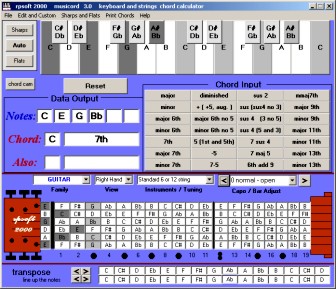| |
Forward
This page shows example usage of
rpsoft 2000 software "musicord" for piano chord (or of course
any keyboard chord) applications. To
view the main page of this software and view its main characteristics,
view it here at: musicord.
| |
 |
|
| |
|
|
| |
An example of piano chord usage of the rpsoft 2000
musicord program |
|
Basic Applications:
rpsoft 2000 musicord software can
be used for piano chords, guitar chords,
ukulele chords, banjo chords, bass chords and many other stringed
instruments. This page highlights its usage
for piano chords, or of course, any keyboard type chords. This
software musicord program will convert notes to chords, or will convert
a given chord input to the notes and piano fingering.
Chords to Notes
To determine the
notes in a chord such as C major, one begins by entering the C by either
pressing a C on the piano keyboard or a C on the guitar fret board.
Then use the mouse pointer to select the “major” button on the chords at
the right middle of the program. The notes are then shown in the
data output. The fingering is also show on the piano and on the
guitar fret board.
Notes to Chords
One can also enter
notes on the piano keyboard or the guitar fret board, and then see if
the software program recognizes the chord. If it does, the program
will show the chord name, (piano chord or guitar chord) and any
alternates, in the data area.
Above Example and Piano Chord (Keyboard Chord) Inversions
The above figure shows the musicord software for a piano chord
application. In this case, a chord was entered, C7th, in order to
find the piano fingering. The piano notes and fingering for this
chord are shown on the piano keyboard at the top of the screen.
The piano fingering shown always will show in dark gray the lowest
(starting at C) fingering that the chord can be made from. The
light gray keys show alternate fingering.
The above example therefore shows the C 7th piano chord fingering
starting with C - and is therefore from the lowest note to highest note:
C, E, G, Bb (note that Bb can also be called A#). However, there
are several different ways to play this C7th chord. These
different types of playing them are called "chord inversions" and for
this musicord program take advantage of the light gray keys.
In the above example, one could for example play a C 7th "chord
inversion" by playing the C high instead of low. Therefore the C
7th chord would be played from lowest note to highest note: E, G,
Bb, C. Other chord inversions would be: G, Bb, C, E or Bb,
C, E, G. In all four cases, the notes are the same. The only
thing that changes in "piano chord inversions" is "which note is played
the highest".
Why use chord inversions
at all? If you have not used chord inversions in the past that
might be a good question. The answers to that question are two:
sound preference and ease of play. For sound preference, sometimes
our ears can indeed tell the difference between one chord fingering and
its inversions. Our ears sometimes will pick up the highest note
as the most noticeable, and there will be a difference in sound.
And musicians may want that different sound. The second item is
ease of play. If one is playing chords with their left hand for
example, and going between a C Major chord and an F Major chord, if the
C Major chord is played first inversion with the C note highest and G
and E below that C, then the transition to the F Major chord will be
easier. In this case, both chords have a C note played high, and
the musician can keep their finger on that C and just move the lower
two. It makes for an easier reference just by feel of the notes
rather than the need for looking or guessing.
Sharp and Flat Handling
Note that in the
above example, that the display shows both the sharp and the flat name
on the keyboard display. This is the option that musicord normally
ships with. However, you can modify this display to show either
all sharps, all flats, choose between two different mixtures of sharps
and flats - or simply select "auto" mode and let musicord select the
most likely mix of sharps and flats for the key that it guesses that you
are in.
Chords Recognized / Created
28 chords in all,
including: major, minor, major 6th, minor 6th, 7th, major 7th,
minor 7th, mmaj7th, major 9th, minor 9th, major 11th, minor 11th, major
13th, minor 13th,diminished, augmented (also called + or +5), major 6
with no 5, minor 6th with no 5, 5, -5, 7-5, sus 2, sus (sus 4 no 3),
sus4 (3 no 5), sus 4 (5 and 3), 7 sus 4, 7 maj 5, 6th add 9.
More Options
Even more options,
including printing, or other instruments shown on the
main musicord page. To see these,
click here.
Relevant Links
(includes this page)
General:
Musicord Software- main page,
Left Hand Chord Example,
Retuned Strings Example
Musical Instrument
Families
Keyboard / Piano,
Guitar / Tiple,
Bass Guitar,
Ukulele,
Banjo, Mandolin / Bouzouki /
Cittern,
Violin / Fiddle / Viola / Cello,
Steel Guitar / Dobro,
Lute / Oud / Cumbus
Click Here for
eBook Info on One Person Band Recording
If you wish to Download and Try,
Click
here for the Download page. Note that you must also agree with our
rules and liability exclusion.
return
To rpsoft 2000 software
|
|